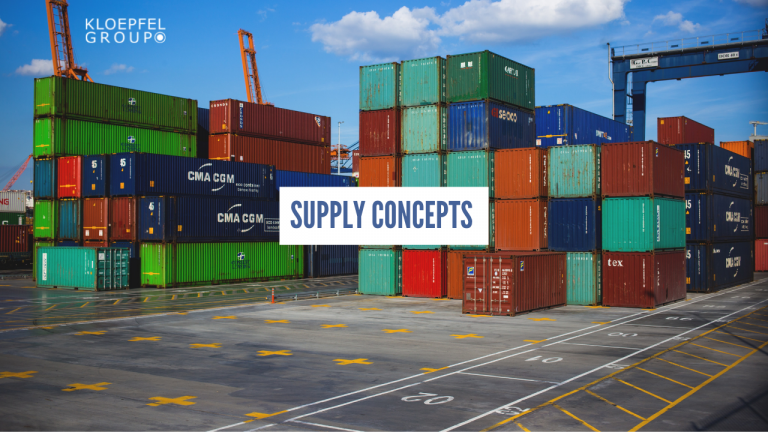Supply concepts
Currently, shortage situations are shaping many supply chains. In fact, companies are working to link traditional supply chains more directly with end-customer requirements.
Taking the pulse of customers and passing it on

Dell’s supply chain has long been the model. Customers select their specific configuration and walk past the checkout with their online shopping cart. Only after the order is received does Dell procure components from suppliers to assemble the IT equipment as needed with the specifically configured parts before shipping. In addition to satisfied customers, net working capital is negative because Dell receives money from customers before accounts payable are due for payment.
Traditional machinery and equipment manufacturers can only dream of this. Until acceptance, value creation can take many months. End customers are used to delivery times of many months. In selected sectors, however, demanders no longer like to wait so long, but want to be able to use a specific machine or install a system after around one month at the latest. The supplier who has a similar machine in stock or can produce it in the time available has a clear competitive advantage. One or the other manufacturer may make do by retooling a similar machine in the short time until delivery, as far as this is technically possible and necessary. The fundamental challenge remains unsolved, namely, to work with suppliers to link the value chains much more directly with customer requirements. And to avoid, as far as possible, long replenishment times, high stock levels and safety stocks, unsaleable slow-moving items, and lost customer orders.
Lean principles in assembly
First of all, the internal assembly department, for example, is set up to be lean in order to shorten its own throughput times and increase flexibility by dispensing with intermediate storage and weeding out inefficiencies. Familiar lean principles such as flow production or takt assembly are introduced. Then, on the procurement side, suppliers are to be connected more directly. The lean processes are extended mentally to the suppliers. Whether this succeeds depends on a whole series of necessary prerequisites.
Rolling demand forecast
Final demand can often only be forecast in a blurred way. Small changes in demand are over-interpreted and amplified along the supply chain to the procurement source of the smallest individual parts. This whip effect must be avoided. One possible approach is to estimate demand on a rolling basis and to become more and more precise over time via open quotations until concrete orders finally arrive. The information must be communicated transparently throughout the supply chain on an ongoing basis. At the beginning, the supplier only receives a general estimate of the development of sales in the coming year, which helps at least with the rough planning and reservation of resources. In a next step, accents in the development of the product range may become apparent. Finally, possible product characteristics can be identified more precisely from open offers and via empirical values.
Homework for suppliers
Suppliers are also called upon to make the value creation of their key components as lean as possible and with short lead times. Only in this way do they have a chance of responding sufficiently quickly to changing requirements. To eliminate a typical bottleneck, raw materials with long lead times are procured in basic variants and, if necessary, standard components are pre-assembled. Extreme long lead times are also proactively procured. Based on the rolling demand forecast and the agreed rules of the game, the supplier sails as close to the wind as possible. Call-off orders can be finalized and delivered with a short lead time in assembly. Of course, every value chain has its own peculiarities and correspondingly differentiated approaches to solutions.
Workshops and value stream analyses with suppliers
Supply concepts depend on the specificity of the material and the peculiarities of the value chain. For the individual segments in the logistic ABC/XYZ analysis, typical analyses can be carried out and solution approaches defined. Low-value standard parts with continuous consumption are replenished via Kanban.

For value-retaining and complex components with project-specific characteristics, solution approaches can be identified together with the suppliers within the framework of a value stream analysis. Value stream analyses are carried out on site. The value added is jointly analyzed and important key figures are recorded. With many years of experience and often in comparison with similar suppliers, time-consuming restrictions can be quickly identified. If the supplier is still very interested in working with us, it is not difficult to agree on priority measures. Lead times can usually be significantly reduced.
For complex welded assemblies, for example, the necessary capacity is reserved in advance and, at best, the raw material is made available via a pre-material release. The optimization approaches range from simple organizational measures to medium-term investment projects.
Rules of the game in cooperation
For each supplier, identify the specific supply chain and understand the specific requirements. One supplier, for example, works with an internal surface treatment, whereas another supplier has arranged with an external partner supplier. Together, specific optimization approaches can be developed. With regard to the risks to be taken, a balance of interests between supplier and customer must be sought. To this end, the rules of cooperation in particular must be specified. Written agreements are preferable to handshakes, for example by means of a logistics agreement or framework agreements with rules on quantity contracts.
The right supplier for the right parts

The question is also which parts and assemblies go to which suppliers. The right machines, equipment, value-added stages and resources must be available to keep up both in terms of price and throughput times. When in doubt, change suppliers to further reduce replenishment time and very likely prices.
Conclusion
In order to reduce replenishment lead times and closely synchronize supply chains with end customer requirements, supply chain transparency and open communication with suppliers is key. However, not just one key supplier, but the majority of time-critical suppliers need to be aligned with future requirements, otherwise the buck will just move from one bottleneck to another.
Contact:
Kloepfel Group
Christopher Willson
Tel.: 0211 941 984 33
Pempelforter Str. 50
40211 Duesseldorf
Mail: rendite@kloepfel-consulting.com
